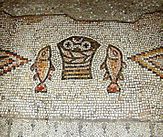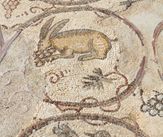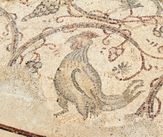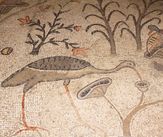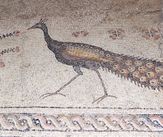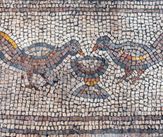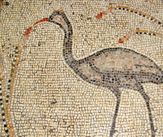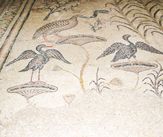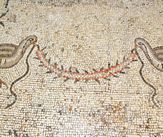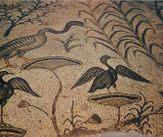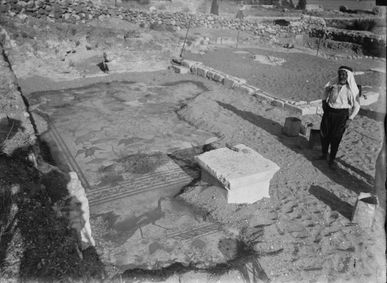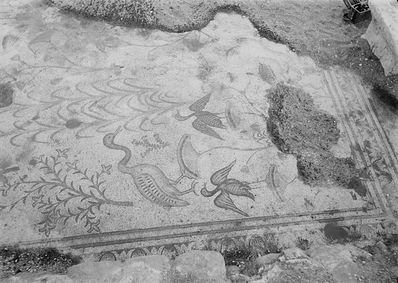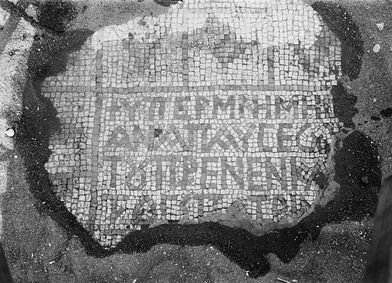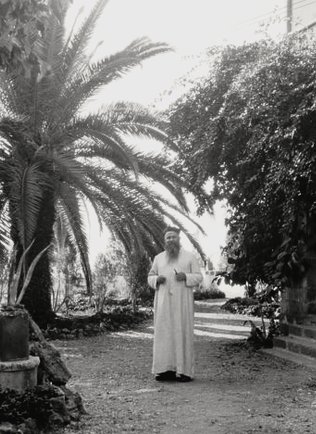MAJOR GORDON'S ARGEOLOGICAL INVOLVEMENT IN SAVING THE MOSAICS AT TABGHA, ISRAEL
The discovery of the church of the Multiplaying in Palestine was made in 1932 and was reported by Mr. Athalstan Rilay in the Shields Daily News on 28 March 1932:
" Discovery of great interest to archaeologists was made in this neighbourhood just before I arrived last week. For some years it was believed that a church lay beneath the soil of this spot on the shore of the Sea of Galilee, and Father Mader and Dr. Shneider of the Goerres Geoellschaft of Cologne resolved to dig on the supposed site. Directly beneath the surface, they found the complete foundations of a large Byzantine church, with beautiful mosaic pavement, a large portion of it representing peacocks, storks, and water-fowl, amid lotus flowers, in almost perfect preservation.
But the great surprise was to come in her well-known 'Peregrinatio', Silvia of Aquitaine, describing her travels in Pales tine in the year 383, speaks of a church built over the stone on which tradition asserted that our Lord multiplied the loaves and fishes in feeding the five thousand; this stone she tells us was visible to the pilgrims. There in the centre of Bema, the explorers found the stone still protruding above the pavement, while at its head, the mosaics showed the basket of loaves and the fishes. The sockets of the four small pillars supporting the mine above the stone are still visible. The whole of the superstructure of the building, including the column, has disappeared. The can be no doubt that the church of the Heptagon, mentioned in the 'Commematoriums' of the beginning of the ninth century has been unearthed. This is only one instance of the discoveries which are now being made with increasing frequency throughout Palestine."
On 14 May 1938, an article was published in the 'The Sphere' newspaper titled "A Scotsman builds a chapel in Galilee".
The articles state that Major A. A. Gordon, a Scottish archaeologist, has built a chapel to preserve the mosaics found on the site of Tabgha, on the Nothern Shore Sea of Galilee. The article also gives the following writing of the origin of the church:
The nun, Etherie Silvia, who visited Palestine in 386, describes the church, saying there was a stone three ft. in width beneath the altar, which she declares was accepted as the spot where Christ stood while distributing five loaves and two fishes.
The basilica was known to have been in existence in the sixth century, but it had entirely disappeared, ruined, it was is believed by an earthquake in the next century, and had since been completely lost. Excavating here a few years ago, father J. Tapper of the Hospice at Tabgha came upon the remains of the altar and mosaic of the loaves and fishes as well as other mosaics of waterfowl, birds, and foliage. True, some of the mosaics were damaged, but archaeologists agreed that they were well worth preserving. The Palestine government was only prepared, however, to make a grant of £100, which was insufficient to meet the cost of placing a building over the site of the basilica. This was necessary to preserve the mosaics from the rains. It was at this juncture that Father Tapper opened his heart to a Scottish friend, Major Gordon. He promptly agreed to raise a sum of £400 and instructed Father Tapper to proceed with the work. The result is the chapel which now marks the site of the miracle.
Johannes Taepper was a Lazarist pilgrim who, in 1913, started to aid Malaria patients at Galilee. Afterwards, he ran a hospice at Tabgha, where the Bedouins worked and trained the civilians in agriculture. He received the nickname "King of Galilee" from his friends, and the jovial, pipe-smoking father founded many Christian schools in Galilee.
